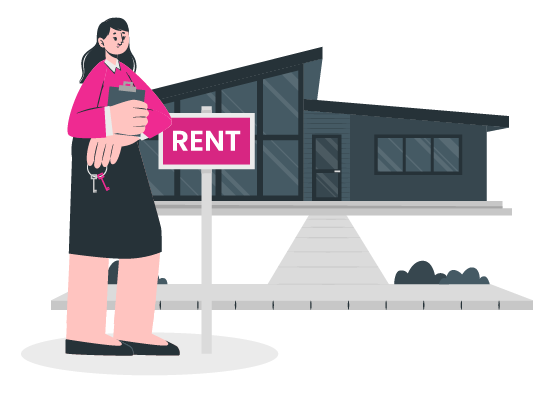Setting the right rental price can feel like a balancing act too high and tenants scroll past; too low and you’re leaving money on the table. One of the biggest influencers? Location. More specifically: Is your property in a city or a town?
While most landlords understand there’s a gap between urban and rural rent levels, the real question is: how much of a gap and why? That’s where a powerful rental estimate tool becomes essential. It can tell you, with data-backed confidence, how your property’s location compares to others across Ireland.
(free, no sign-up, no limits)
Let’s explore how rents differ between cities and towns, and how to set a price that attracts high-quality tenants without guessing.
Why Cities Typically Command Higher Rents
Urban living comes with perks and a price tag. Cities like Dublin, Cork, and Galway offer better access to jobs, transport, universities, entertainment, and healthcare. That demand pushes prices higher.
In contrast, towns tend to offer more space and quieter lifestyles, but they may lack the infrastructure or economic activity that makes cities so appealing to renters.
Factors that drive up city rent include:
- Greater job concentration
- Higher cost of living
- Strong competition for space
- Proximity to public transport and amenities
But the picture isn’t always black and white. Some large commuter towns or tech hubs now rival mid-sized cities in rental prices, especially if demand outpaces supply.
What’s the Average Rent Gap Between Irish Cities and Towns?
Using publicly available data from the Residential Tenancies Board (RTB), we know that average monthly rents in Irish cities are consistently higher than in towns. For example:
- Dublin: €2,000+ for a 2-bed apartment
- Cork City: Around €1,600 for the same
- Galway City: €1,550–€1,700
- Mid-sized towns (e.g. Ennis, Mullingar): €1,000–€1,300
- Smaller towns or rural areas: €800–€1,100
But these figures only tell part of the story. Not every property within a city centre commands top-tier rent. And some town-centre locations, especially near new infrastructure or business parks, are experiencing rent growth.
So how do you know where your property fits? That’s where the FindQo.ie rental estimate tool becomes an invaluable resource.
Using a Rental Estimate Tool to Compare Locations
Whether your property is in bustling Dublin or a quieter town like Naas or Clonmel, accurate pricing matters. Overpricing in a low-demand area can mean longer vacancy periods. Underpricing in a popular suburb could cost you hundreds every month.

Enter the FindQo.ie Rental Estimate Tool
This free tool is built specifically for the Irish market and gives you an instant, data-backed estimate based on:
- Live Market Data: It scans real-time listings from all major rental platforms in Ireland.
- Historical Insights: It looks at how similar properties have been priced and rented in your specific location.
- Exclusive FindQo Intelligence: AI-powered insights that detect pricing patterns based on factors like local demand, property type, features, and geography.
(free, no sign-up, no limits)
By combining live data with proprietary intelligence, the tool highlights how much location truly affects rent—and helps you set the right price whether you’re in a major city or a quiet town.
The Commuter Belt: Town Rents Catching Up to Cities?

In recent years, Ireland’s commuter belt has blurred the lines between “city” and “town.” As people move further out for affordability, towns within 30–60 minutes of major cities have seen rental demand soar.
Some towns where this trend is especially visible include:
- Maynooth and Leixlip (Dublin commuter towns)
- Midleton (commutable to Cork)
- Oranmore (close to Galway)
In many of these locations, rents now match or even exceed those of less popular city suburbs.
A rental estimate tool accounts for these micro-trends, providing clarity on what your property is truly worth in today’s ever-shifting rental landscape.
How Property Type Changes the Equation
Location is only part of the rent puzzle. A two-bedroom apartment in a city might cost more per square metre, but a detached home in a town might offer more overall value—even at a lower monthly rent.
Here’s how property type can skew rent comparisons:
- Apartments: More common (and more expensive) in city centres.
- Houses: More available in towns and suburbs; often attract families.
- New builds vs older homes: Energy efficiency, modern features, and parking all influence price.
When using the FindQo.ie rental estimate tool, simply select your property type and features such as number of bedrooms, parking, or garden and it adjusts the estimate accordingly.
Setting the Right Rent: A Data-Driven Approach
Every landlord wants to maximise income, but setting the wrong rent too high or too low can have lasting consequences.
Here’s how the rental estimate tool helps you strike the right balance:
- Avoid long vacancies by pricing competitively in lower-demand towns
- Capture full market value in high-demand cities or commuter towns
- Understand local trends instead of relying on national averages
Whether you’re renting out a one-bed in Limerick or a three-bed in Athlone, the FindQo.ie tool uses real Irish rental market data to help you price smarter.
(free, no sign-up, no limits)
Know Your Location, Know Your Rent

The rent gap between cities and towns in Ireland is real but it’s also evolving. More people are working remotely, commuting further, and re-evaluating where they live. As a result, some towns are catching up in rent, while others lag behind.
The key takeaway? Location still matters but context matters more.
By using a rental estimate tool, especially one powered by live data and AI like FindQo.ie, you can take the guesswork out of setting your rent regardless of whether your property is in a major city or a small town.
Want to know your property’s rental potential right now?
(free, no sign-up, no limits)
Let smart data guide your rental strategy and start attracting better tenants, faster.

